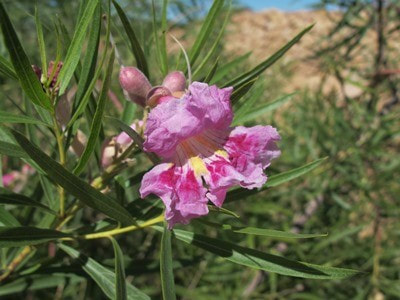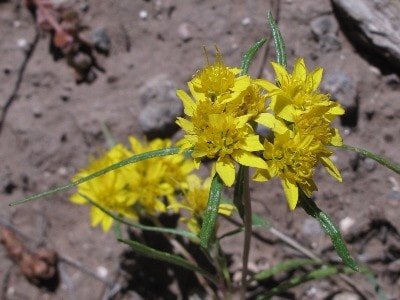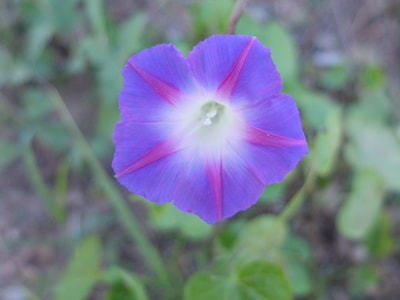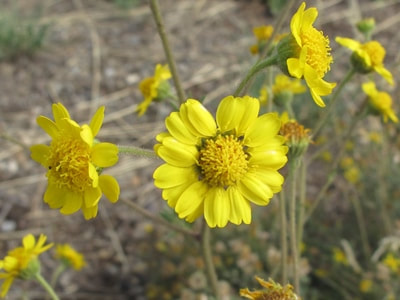|
The Bloom Blog
Blooming this week in the environs of Abiquiú By Wildflowers of the Southern Rocky Mountains Found in dry washes, terraces of flood plains Seen blooming in September at Abiquiu Lake Although this lovely flower is blooming in the landscaping at Abiquiu Lake Visitor Center, Desert Willow is a native in southern New Mexico and Arizona growing at elevations below 5,500 feet. It would usually bloom in May/June but good summer rains can produce a second bloom. It is a shrub that can grow to be a 30-feet tall tree. Its leaves are long and narrow and willow-like but it is not related to Willows. The orchid-like, trumpet-shaped flowers are up to two inches long and showy, pink with yellow ridges and purple stripes inside. The brown seed pods are 8 inches long and narrow. Traditionally, the Havasupai used Desert Willow in basketry; Hualapai used it to make cradleboards. It is anti-microbial and anti-fungal; curanderas in Mexico use it to treat coughing, indigestion, and skin and vaginal infections. Source. If you are trying to identify a different flower then you can check what other flowers bloom this month. If you cannot identify a flower from the website, send a photo and where you took it to [email protected]. Read online for tips
0 Comments
Found in sandy, gravelly, dry areas
Seen blooming in September off FS Rd 23 in the Juan Jose Lobato Grant Lemonscent is usually inconspicuous but when summer rains come at just the right time this fast-growing annual can produce mats of yellow in deserts, grasslands, woodlands, and along roadsides. It is a low-growing compact plant usually an inch or two high but can be eight. The leaves are narrow and dotted with glands which give off a strong smell of lemons when they are crushed. The flowers are less than ½ inch across and grow in clusters at the tips of the stems with eight pointed bright yellow petals. The Hopi, Zuni, and Havasupai Indians have used Lemonscent as a wild food plant for centuries. Dried and crushed plants can be sprinkled on chicken while cooking, thrown into a stew, added to cornbread or other bread recipes for zest, or added to your favorite tea for a lemony treat. Source. If you are trying to identify a different flower then you can check what other flowers bloom this month. If you cannot identify a flower from the website, send a photo and where you took it to [email protected]. Read online for tips. Found in dry waste areas, roadsides
Seen blooming in September at Los Alamos Airport Anyone suffering with a runny nose, itchy eyes and sneezes should know that Ragweed could be the cause, not COVID-19. Ragweed pollen is considered the number one cause of hay fever in the late-summer and fall. Each plant can produce over a billion grains of pollen per season which occurs from mid-August until frost. This Ragweed is one of several species of Ragweed that grow in our area. It grows to 3 feet high, erect or sprawling, with deeply lobed hairy leaves. Although weedy in appearance, on closer inspection the flower structure is interesting. Male flowers hang from the top portion of the stem like little umbrellas with a dark stripe and can look yellowish due to the color of the pollen-laden stamens. Female flower heads below are spiny burr-like structures in the leaf axils. The fruits are very spiny and painful to touch. Native Americans used an infusion of the plant for menstrual obstructions, and the ground root was placed in the tooth for toothache. The ash of the leaves was used in ceremonies. The scientific name, ambrosia, is Greek for food of the gods, while acanthicarpa means having thorny fruits, hardly food for the gods. Source. If you are trying to identify a different flower then you can check what other flowers bloom this month. If you cannot identify a flower from the website, send a photo and where you took it to [email protected]. Read online for tips. Found in disturbed soil, moist areas
Seen blooming in September near the Rio Chama The brilliantly colored Tall Morning Glory is a native of Mexico and Central America and has escaped to the wild from cultivation in the USA. It can grow to 10 feet long, creeping, climbing and twining around other plants, fences and trees. The leaves are heart-shaped or have three to five lobes and the stems are covered with brown hairs. The flower is trumpet shaped and up to 2½ inches across with five petals that are usually blue, purple, pink, or some combination of these colors, with a white throat. The flowers open in the morning and close in the afternoon. Native American use is not recorded but it is used in Chinese and Ayurvedic medicine as an anthelmintic, diuretic and laxative, and in the treatment of various mental disorders. Source. If you are trying to identify a different flower then you can check what other flowers bloom this month. If you cannot identify a flower from the website, send a photo and where you took it to [email protected]. Read online for tips. Found in disturbed soil, gravel slopes, roadsides
Seen blooming in September above Abiquiu Lake Ragleaf Bahia grows to three feet tall in an open, airy form. Stems are reddish, spreading and leafless. Flowers are about one inch across. The ray flowers overlap and are rounded and slightly notched. The leaves are mostly at the base of the stem and divided into fine lobes. Traditionally, an infusion of the plant was used as a cathartic, emetic, contraceptive, to ease menstrual pain, and for headache, rheumatism and arthritis. Source. If you are trying to identify a different flower then you can check what other flowers bloom this month. If you cannot identify a flower from the website, send a photo and where you took it to [email protected]. Read online for tips. |
AuthorI am Marilyn Phillips, a native of England, whose love of nature and the outdoors from childhood brought me by a circuitous route to Crested Butte, Colorado in 1993 and 16 years later to northern New Mexico. My exploration of the many trails in these areas, my interest in wildflowers and photography, and career in computer system design came together in this creation. If you have any corrections, comments or questions, please contact me by email. Archives
September 2025
Categoriescopyright © 2020
|







 RSS Feed
RSS Feed